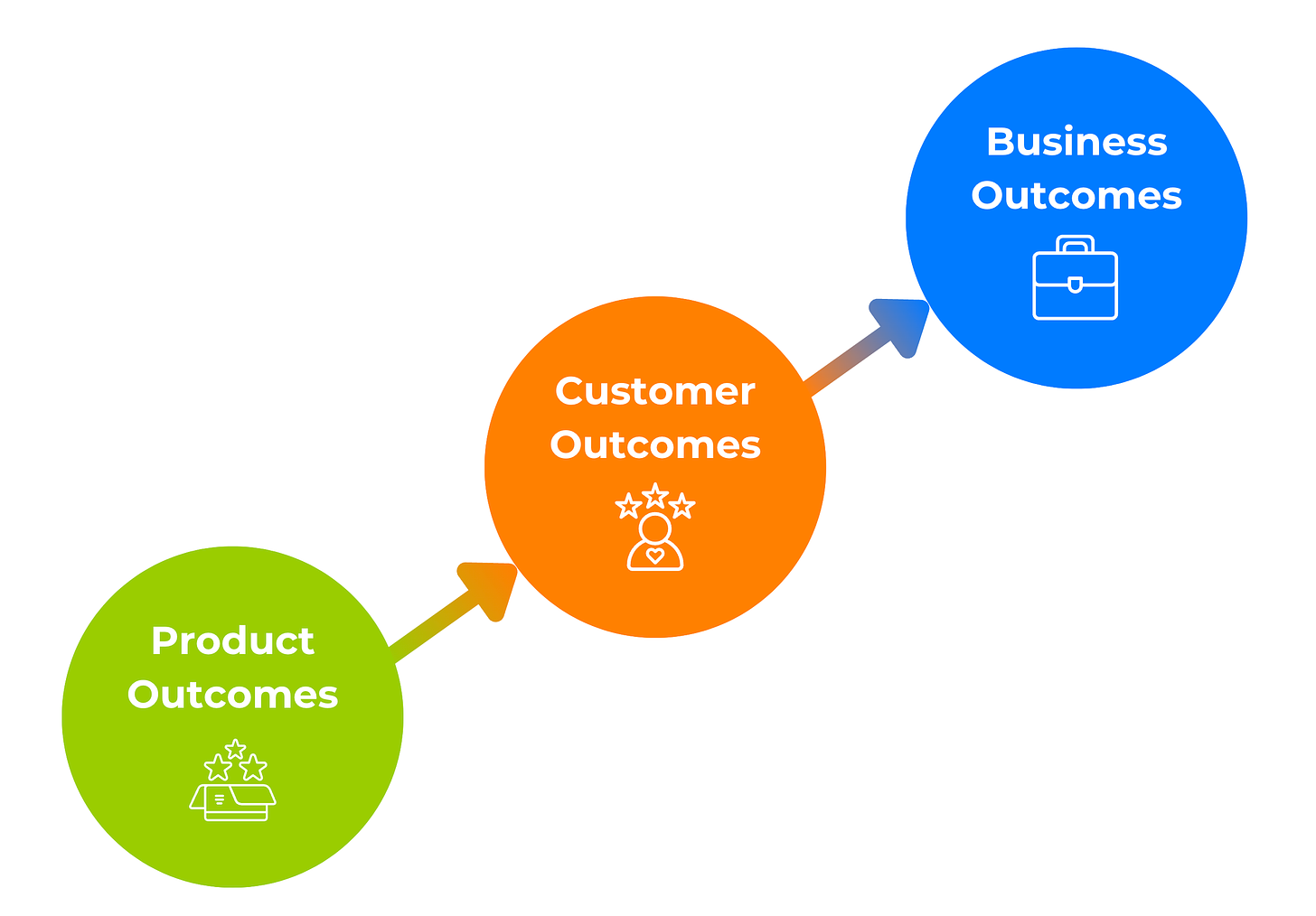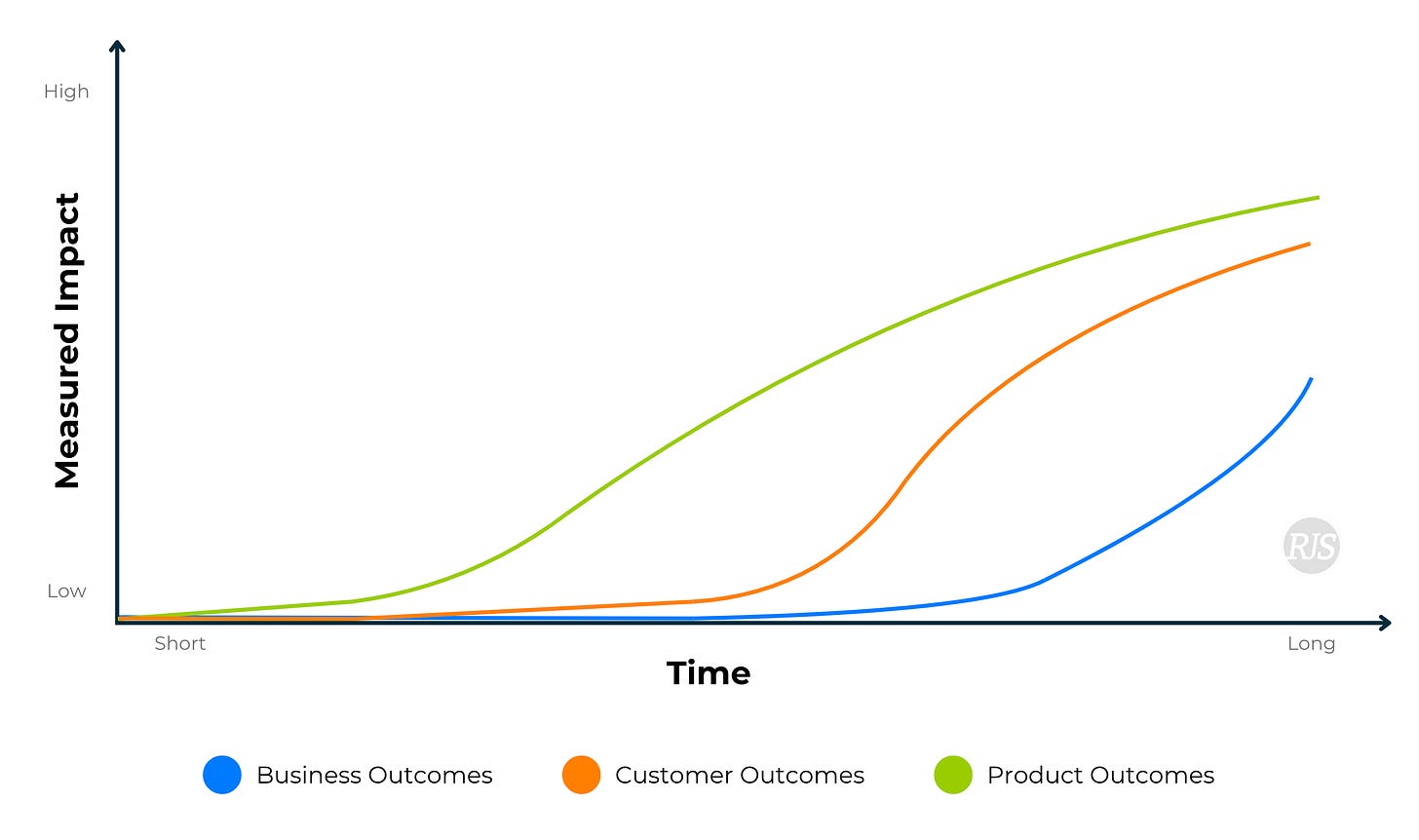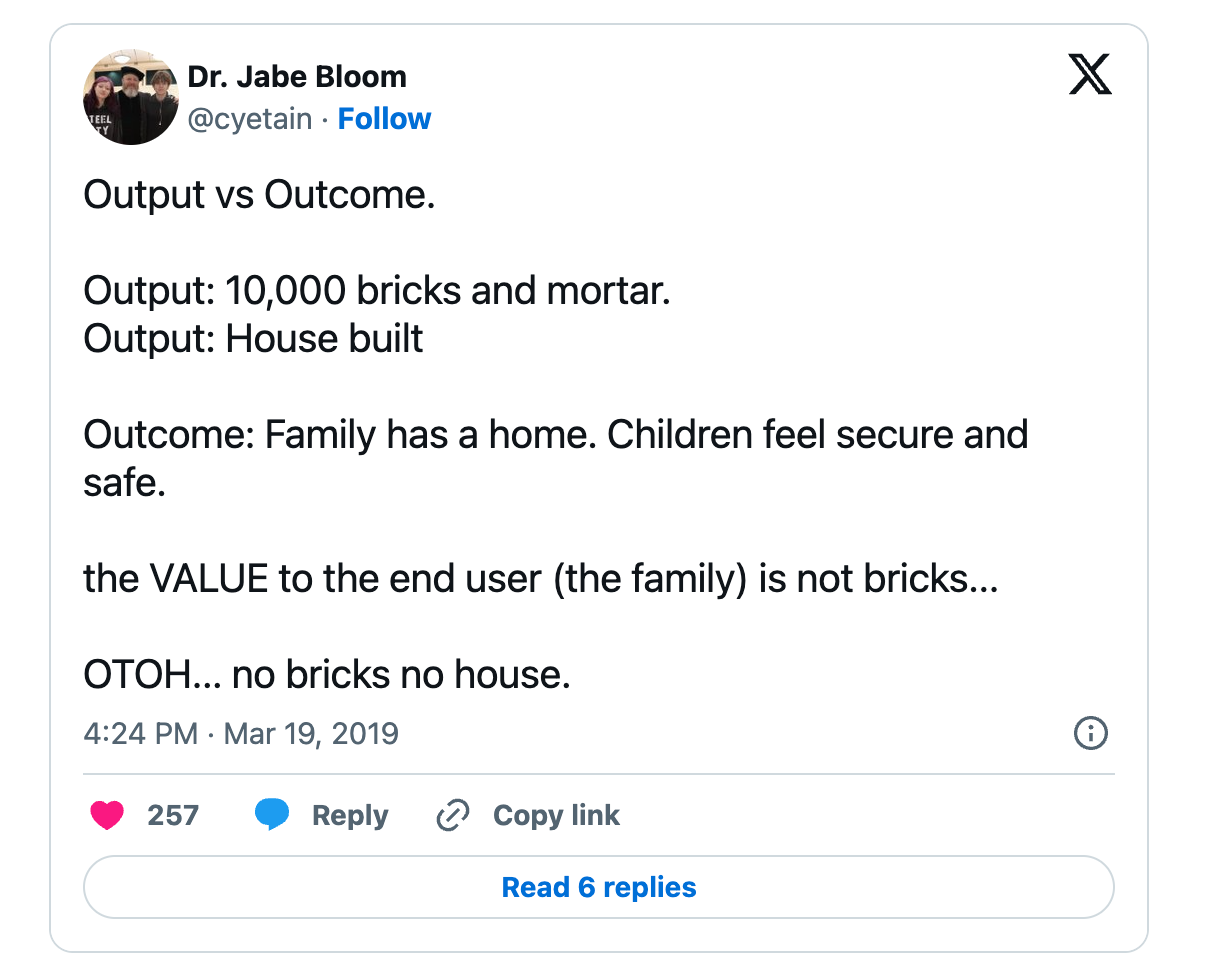One of the most significant shifts I’ve made in my career is moving from “Look at this cool feature!” to “How does this feature drive the outcomes we’re aiming for?” At CRISP, the first step in product development is always to understand the outcomes we want to influence.
Unfortunately, many product teams are stuck in environments where success is measured by how many features get shipped rather than the impact those features create. How often have you heard leadership say, “We need to deliver feature X by the next quarter,” without discussing the why? We push for delivery milestones, often overlooking whether what we’re delivering brings real value.
Sound familiar?
Through experience, I’ve learned that the real measure of success in product development isn’t how much we deliver but what that delivery achieves. To make meaningful progress, shifting focus from outputs (features) to outcomes (impact) is essential.
What’s the difference in Product Development?
- Outputs: The tangible things you deliver, like features or products.
- Outcomes: The value and impact that results from those outputs.
This post from X illustrates it well:
In this post, I’ll explain how you can use outcome-driven thinking to make more informed decisions and achieve better customer and business results.
Here Are Five Reasons I Think Outcomes Will Make Your Life Easier in Product Development:
- Outcomes Drive Real Value: When you focus on outcomes, your efforts align with the CRISP methodology’s emphasis on delivering true value to customers and the business rather than simply shipping features to meet a deadline.
- You Become More Efficient: Think of it like the 80/20 rule (Pareto principle): 20% of your efforts lead to 80% of your results. By prioritizing outcomes, as outlined in the CRISP framework, you can focus on what truly moves the needle, reducing wasted effort.
- It Simplifies Communication: Understanding what you’re trying to achieve makes it easier to explain your ideas. CRISP facilitates clear communication by emphasizing how your work delivers value rather than just listing features.
- It Encourages Innovation: Focusing on outcomes means thinking outside the box. You’re not restricted by the number of features you’ve planned to release. Instead, CRISP empowers you to explore new ways to achieve the desired impact.
- It’s Easier to Measure Success: While outputs are easy to count (like the number of features or lines of code), they don’t tell you if you’re making a difference. Measuring outcomes helps you understand if your work is driving change, like “We increased user engagement by 20%,” which is far more meaningful than “We shipped 20,000 lines of code.”
How I Incorporate Outcomes Into My Product Development Process
A few years ago, I had my first “aha” moment when I realized I wasn’t effectively articulating the outcomes my product needed to achieve.
That’s when I started breaking down outcomes into three main categories:

Organizing outcomes this way allows you to align with your company’s goals, understand the problems your customers are facing, and then focus on delivering products or features that directly address those needs.
Business Outcomes
Think of business outcomes as your North Star. Your company aims to achieve these measurable, quantifiable goals through its products, services, or operations. Commonly defined in three areas:
- Financial Outcomes:
- Revenue growth: Increasing sales and revenue.
- Profitability: Improving profit margins.
- ROI: Ensuring that investments generate a positive return.
- Cost reduction: Identifying and implementing cost-saving measures.
- Market Outcomes:
- Market share: Expanding the company’s share of the target market.
- Customer acquisition: Attracting new customers.
- Customer retention: Reducing churn and maintaining long-term relationships.
- Brand awareness: Enhancing brand visibility and recognition.
- Operational Outcomes:
- Efficiency: Improving operational processes.
- Productivity: Boosting employee output and performance.
- Quality: Delivering high-quality products and services.
- Innovation: Fostering a culture of innovation and new product introductions.
Customer Outcomes
These offer a broader view of how individual outcomes impact the customer, reflecting the desired results that influence customer experience, satisfaction, loyalty, and perceived value of your product or service. Consider these areas:
- Customer satisfaction: Gauging overall satisfaction with the product or service.
- Customer loyalty: Encouraging repeat purchases and fostering long-term relationships.
- Customer advocacy: Turning customers into brand advocates who spread positive word-of-mouth.
- Customer lifetime value (CLTV): Maximizing total revenue each customer generates.
- Customer churn: Reducing churn and keeping customers engaged.
- Customer experience: Enhancing the overall journey, from onboarding to ongoing support.
- Perceived value: Ensuring customers feel the product is worth its price.
Product Outcomes
Finally, product outcomes focus on how effectively your product delivers value. Consider metrics like product/feature adoption, user engagement, and user satisfaction:
- Product adoption: Measuring the rate at which users adopt and use the product.
- User engagement: Tracking behavior, such as frequency of use and interaction with critical features.
- User satisfaction: Assessing users’ happiness with the product’s usability and functionality.
- Product features: Evaluating which features are most used and provide the most value.
- Customer acquisition: Tracking how the product drives customer growth.
- Revenue generation: Assessing how the product or individual features contribute to the company’s bottom line.
- Market penetration: Measuring how deeply the product has penetrated the target market.
Outcomes Influence Each Other
One crucial insight is that Business, Customer, and Product Outcomes are deeply interconnected. Changes in product outcomes influence customer experiences, which drive business results.

Example: A New Onboarding Flow
Imagine a SaaS platform that introduces a simplified onboarding flow.
- Product Outcome: Adopting this new flow by new users is a clear product outcome.
- Customer Outcome: This change enhances customer experiences by making the platform more intuitive and user-friendly. Users can quickly grasp the platform’s features and reduce the time it takes to realize value.
- Business Outcome: A smooth onboarding process leads to increased customer satisfaction. Satisfied users are more likely to remain engaged, boosting customer retention rates. Furthermore, positive experiences lead to word-of-mouth referrals, enhancing customer acquisition.
This example illustrates how a well-executed product change can create a ripple effect, driving significant improvements in customer and business outcomes.
But Impact Doesn’t Happen Overnight
It’s essential to understand that the changes in product, customer, and business outcomes occur at different speeds:

- Product Outcomes are typically the first to shift because they relate directly to your immediate efforts. After launch, you may quickly see changes in metrics like feature adoption or user engagement.
- Customer Outcomes take a bit longer to manifest. You’ll need to gather feedback, assess customer satisfaction, and observe how your product integrates into their routines. Metrics like customer loyalty, advocacy, and lifetime value evolve as trust builds.
- Business Outcomes usually change the slowest. They are the cumulative result of product and customer outcomes aligning over time, and it may take months or even years to see improvements in profitability, market share, or brand awareness.
Understanding when to look for results is vital. This perspective helps you focus on what matters most at each product lifecycle stage.
Some Other Learnings to Be More Outcome-Focused in Product Development
Shifting your mindset from outputs to outcomes requires intentional practice. Here are some strategies that have helped me stay focused on outcomes:
Start With the End in Mind
Before development begins, clearly define the specific business, customer, and product outcomes you aim to achieve. This will serve as your North Star, guiding your decisions.
Validate Assumptions Early
Don’t wait until a feature launches to determine if it will achieve the desired outcomes. Use prototypes, beta tests, or customer interviews to validate that your efforts align with users’ needs.
Measure the Right Things
It’s easy to get lost in vanity metrics like the number of features shipped. Instead, focus on outcome-based metrics that reflect real value, such as user retention, engagement, and increased revenue.
Iterate Based on Results
After your product is live, continually refine it based on your desired outcomes. Are users adopting the feature as expected? Is customer satisfaction improving? If not, pivot quickly.
Communicate Success
Ensure your team and leadership align with outcome-focused goals. Share how each decision connects back to the business’s larger objectives and highlight wins regarding impact, not just feature delivery.
Take the Next Step in Your Product Development Journey
Product development can be challenging, but you don’t have to do it alone. Join the growing community of product managers and entrepreneurs who are shifting their focus to drive meaningful outcomes.
Get the Toolkit to Transform Your Strategy!
Our comprehensive toolkit is designed to help you prioritize outcomes, minimize risk, and align with customer needs. With practical resources, templates, and actionable insights, you’ll have everything you need to make a lasting impact.
Ready to elevate your approach?








